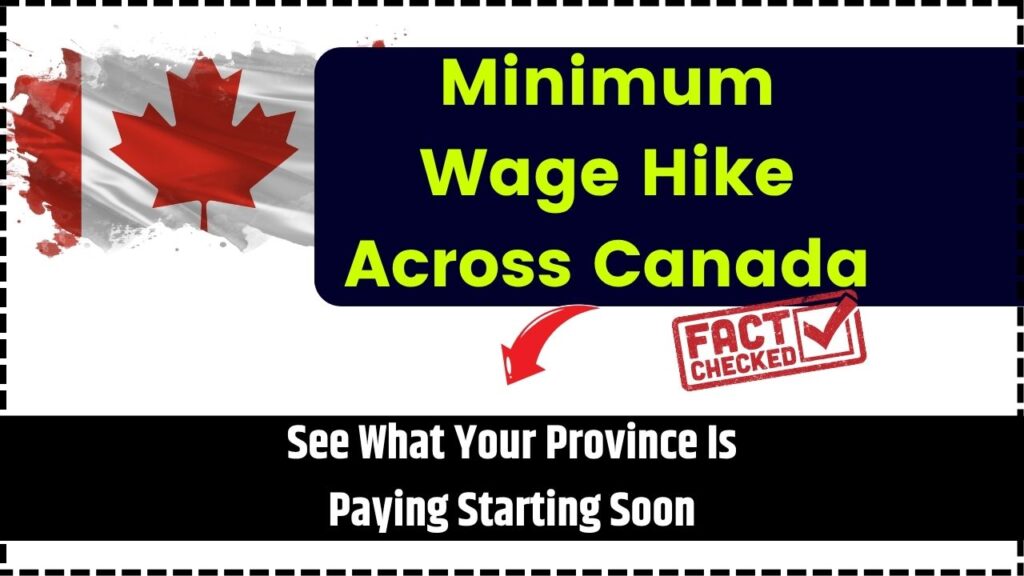Minimum Wage Hike Across Canada: In 2025, Canada’s minimum wage is going up across the board, with most provinces and territories seeing increases. This guide will help you navigate the upcoming changes, understand how they stack up, and provide practical advice whether you’re a worker, employer, or simply someone curious about labor trends.
Minimum Wage Hike Across Canada
Canada’s 2025 minimum wage hikes signal a commitment to fair pay and economic balance. While these increases bring challenges, they also offer opportunities for growth and innovation. By staying informed and proactive, both workers and employers can thrive in this evolving landscape.

| Province/Territory | Current Wage | New Wage | Effective Date | Notes |
|---|---|---|---|---|
| Federal | $17.30 | $17.75 | April 1, 2025 | For federally regulated sectors |
| Alberta | $15.00 | $15.00 | No Change | |
| British Columbia | $17.40 | $17.85 | June 1, 2025 | CPI-linked |
| Manitoba | $15.80 | $16.00 | Oct 1, 2025 | CPI-linked |
| New Brunswick | $15.65 | $15.65 | April 1, 2025 | |
| Newfoundland & Labrador | $16.00 | $16.00 | April 1, 2025 | |
| Nova Scotia | $15.70 | $16.50 | Oct 1, 2025 | CPI + 1% |
| Nunavut | $19.00 | $19.00 | Jan 1, 2024 | Highest |
| Ontario | $17.20 | $17.60 | Oct 1, 2025 | CPI-linked |
| Prince Edward Island | $16.00 | $16.50 | Oct 1, 2025 | $17.00 in April 2026 |
| Quebec | $15.75 | $16.10 | May 1, 2025 | Tipped: $12.90 |
| Saskatchewan | $15.00 | $15.00 | No Change | CPI-linked |
| Northwest Territories | $16.70 | $16.70 | No Change | CPI & wage-linked |
| Yukon | $17.59 | $17.94 | April 1, 2025 |
Context and Why It Matters
Let’s start with some background. Minimum wage in Canada is the lowest legal hourly pay an employer can offer workers. It’s set by each province and territory but aligned to ensure workers can keep pace with rising costs of living. In recent years, as inflation and living expenses soared, governments across Canada responded by hiking minimum wages.
For example, while Alberta’s rate has been stagnant at $15.00/hour since 2018, provinces like British Columbia, Ontario, and Nunavut have introduced substantial increases. This move isn’t just about economics—it’s about fairness, equity, and keeping Canada’s workforce competitive.
Historical Context: A Look Back
Canada’s minimum wage laws date back to the early 20th century when they were first introduced to protect vulnerable workers. Over time, provinces adjusted these rates to reflect inflation, economic growth, and social pressures. For example, Ontario’s first minimum wage was set in 1965 at $1.25/hour. Since then, rates have steadily climbed.
How Minimum Wage Hike Across Canada Compares to the U.S.?
Many folks wonder, “How does Canada’s minimum wage compare to the U.S.?” Well, as of 2025, Canada’s federal minimum wage is $17.75/hour, while in the U.S., the federal minimum wage remains $7.25/hour—a rate unchanged since 2009. However, some U.S. states, like California, are pushing up to $16/hour or more.
Economic and Social Impacts
Raising the minimum wage can be a double-edged sword. On one hand, it increases workers’ spending power, reduces poverty, and boosts local economies. On the other hand, businesses might face higher costs, leading to reduced hiring or price adjustments.
Consider British Columbia’s jump to $17.85/hour. This change is a lifeline for workers struggling with high rents and living costs. But it also pushes businesses, especially small ones, to innovate—whether that’s adopting technology, improving productivity, or adjusting pricing.
Real-Life Example
Lila, a café owner in Nova Scotia, shared, “When the wage went up to $15.70, it was tough at first. But we adapted. We streamlined operations, and now we’re stronger than before. Plus, our staff morale improved. The new $16.50/hour in October 2025? We’re ready!”
Expert Insight
According to Dr. Jasmine Lee, a labor economist at the University of Toronto, “Minimum wage increases, when implemented thoughtfully, can drive productivity, reduce turnover, and ultimately benefit the broader economy. However, the key lies in balancing wage growth with business realities.”
Practical Tips
For Workers:
- Check Your Pay: Once the increase kicks in, review your paycheck to ensure compliance.
- Know Your Rights: Learn about overtime, breaks, and special rates (like student wages) in your province.
- Stay Updated: Bookmark official provincial labor pages and sign up for updates.
For Employers:
- Update Payroll: Adjust systems to reflect the new rates and avoid penalties.
- Communicate Clearly: Hold meetings or send memos to staff explaining changes.
- Budget Wisely: Factor wage increases into your financial plans to stay competitive.
Canada’s Massive $12000 EV Rebate in 2025 – Here’s How to Claim It!
CRA Surprise Payout Coming Summer 2025 – Are You Getting It?
Canada’s $2200 Payment Hits This Month—Are You Eligible for the Cash?
Frequently Asked Questions (FAQs)
Q: When will the new minimum wages take effect?
A: Changes vary by province, with most occurring between April and October 2025.
Q: What’s the highest minimum wage in Canada?
A: Nunavut at $19.00/hour, effective since January 1, 2024.
Q: Do all employees get the same minimum wage?
A: No, some categories like students or tipped employees may have different rates.
Q: Where can I find the most up-to-date rates?
A: Check Retail Council of Canada’s website for current details.











